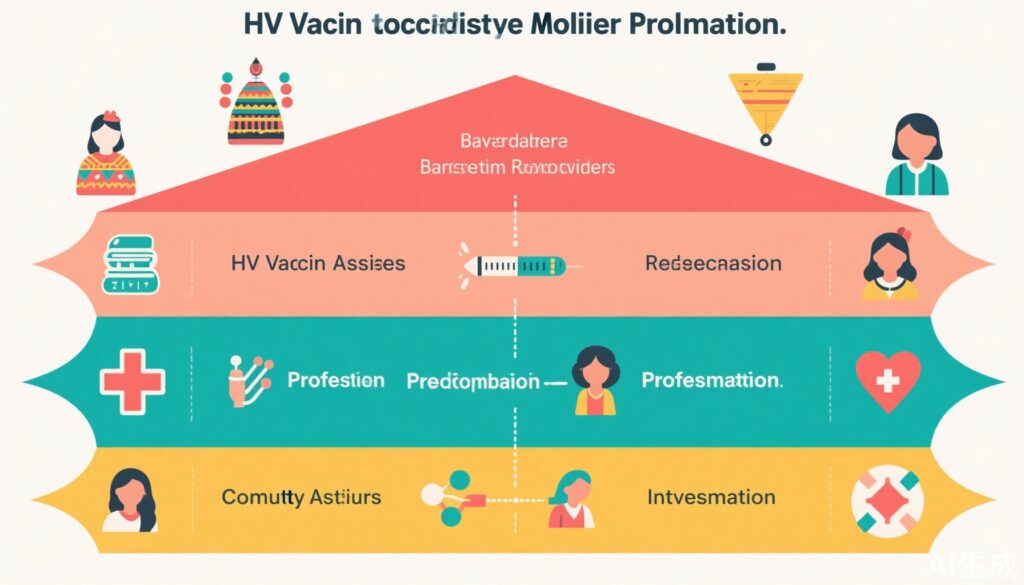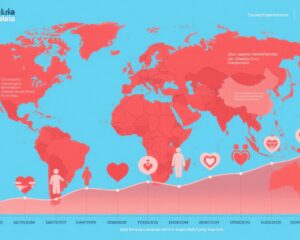Highlights
- Migrants globally exhibit substantially lower HPV vaccination uptake than WHO targets, ranging between 17% and 23% depending on sex.
- Key barriers include safety concerns, cultural beliefs, misinformation, limited knowledge, language and logistical challenges, and vaccine cost.
- Positive facilitators encompass trust in health providers, social support, provider recommendations, and parental acceptance of adolescent vaccination.
- Effective strategies emphasize culturally sensitive messaging, trusted community mediators, reducing access barriers, integrated vaccination services, eHealth solutions, and robust vaccination monitoring.
Background
Worldwide, human papillomavirus (HPV) infection remains a leading cause of cervical and other anogenital cancers. The WHO’s Cervical Cancer Elimination Initiative aims for 90% of girls vaccinated against HPV by age 15 by 2030 to drastically reduce mortality. Despite vaccine availability, global coverage remained at only 27% in 2023. Migrant populations, encompassing first- and second-generation foreign-born individuals, are significantly under-immunized for HPV vaccines, facing heightened vulnerability to HPV infection and related cancers. Recognizing the critical need for targeted approaches, this comprehensive review systematically investigates drivers of vaccine uptake in migrant populations and evaluates evidence-based interventions to improve coverage.
Key Content
Study Scope and Methodology
A systematic review and meta-analysis encompassing 117 studies (Jan 2006–Dec 2024), covering 5,638,838 participants across 16 countries plus one territory, with 933,189 migrants (first- and second-generation) was conducted. Studies included qualitative and quantitative observational designs, and randomized controlled trials focused exclusively on foreign-born migrants, excluding internal migrants. Outcomes comprised rates of HPV vaccine uptake, qualitative drivers and barriers, and identified interventions to improve coverage. The WHO Behavioural and Social Drivers of Vaccination model framework guided thematic analysis, while pooled vaccine uptake was estimated via random-effects meta-analysis. Bias was evaluated using Joanna Briggs Institute checklists.
Pooled Vaccine Uptake Estimates
– Female migrants: 23.0% (95% CI: 10.0–44.0; I2=99.3%; n=7,614)
– Male migrants: 21.0% (95% CI: 5.0–58.0; I2=99.3%; n=2,764)
– Combined sexes: 17.0% (95% CI: 8.0–33.0; I2=98.0%; n=3,583)
High heterogeneity reflects diverse contexts and populations studied.
Barriers to HPV Vaccine Uptake
– Individual Level: Widespread concerns regarding vaccine safety and side effects, low awareness or knowledge about HPV and vaccines, uncertainty stemming from misinformation, and skepticism fueled by negative information exposure.
– Cultural and Social Factors: Cultural beliefs opposing vaccination linked to perceptions about adolescent sexuality, religion-based hesitancy, and social norms discouraging preventive vaccination.
– Healthcare Provider Interactions: Absence or weak recommendation from healthcare providers critically undermined vaccine uptake.
– Systemic and Practical Barriers: Limited availability of culturally and linguistically appropriate information, language barriers, logistical challenges including clinic hours and transportation, and high out-of-pocket vaccine costs, especially in low- and middle-income settings or where vaccines are unfunded.
Enablers Driving Uptake
– Trust and positive perceptions of vaccines and healthcare providers facilitated acceptance.
– Realistic parental expectations about adolescents’ sexual activity lowered resistance to vaccination.
– Strong provider recommendations, perceived parental and adolescent responsibility.
– Supportive peer and social networks illuminated the social diffusion of pro-vaccine attitudes.
Recommended Strategies and Intervention Approaches
– Culturally Sensitive Messaging: Tailoring educational content to address diverse cultural and linguistic needs of migrant subgroups, targeting parents/caregivers and adolescents distinctly.
– Trusted Community Mediators: Engagement of peer school health promoters, religious leaders, community health workers, and other trusted figures to bridge cultural gaps and propagate vaccine confidence.
– Practical Interventions: Bundling HPV vaccination with other health services to reduce missed opportunities; walk-in clinics, mobile outreach services, and flexible scheduling to overcome logistic hurdles.
– Use of eHealth and Digital Communication: Leveraging social media, mobile apps, and other digital tools to disseminate credible vaccine information and reminders.
– Strengthening Provider Recommendations: Training and supporting healthcare providers to provide strong, confident, and culturally competent vaccine counseling.
– Vaccination Monitoring Systems: Development and maintenance of robust registries to identify coverage gaps and monitor progress within migrant populations.
Expert Commentary
The review robustly synthesizes a vast and diverse literature base, identifying the multifactorial barriers hindering HPV vaccine uptake within migrant communities globally. The extremely high heterogeneity in uptake rates reflects variability in health systems, sociocultural environments, and migrant origins. Critically, individual-level hesitancy is intertwined with systemic and structural barriers, necessitating multipronged interventions that are culturally tailored and community-led.
The role of healthcare providers emerges as pivotal, emphasizing the need for enhanced provider training and proactive vaccine recommendation practices. Recognizing cultural beliefs around sexuality and vaccination, interventions must respect these values while providing factual, sensitive information. Deploying trusted mediators within communities is a particularly effective strategy previously demonstrated in vaccine programs for other diseases.
The findings underscore substantial inequities in vaccine access in low- and middle-income countries, where costs and limited vaccine availability present additional barriers. From a public health perspective, integrating HPV vaccination into broader immunization programs, school health services, and primary care tailored to migrant needs may improve uptake.
Limitations of the source studies include reliance on self-reported uptake in some surveys, cross-sectional designs limiting causality inferences, and inconsistent migrant definitions across countries. Future research should focus on randomized trials assessing intervention effectiveness in diverse migrant settings and longitudinally monitor uptake and impact.
Conclusion
Migrants worldwide experience persistent, complex barriers at individual, social, provider, and system levels contributing to suboptimal HPV vaccine uptake and missed opportunities to prevent HPV-related cancers. Addressing these requires comprehensive, culturally sensitive, community-engaged, and system-wide approaches. Collaboration with migrant communities to co-develop tailored delivery models is essential. Policy commitments to universal equitable immunization, vaccine affordability, and access, particularly in low-resource settings, must be strengthened to realize the WHO cervical cancer elimination goals.
References
- Iwami M, Bouaddi O, Razai MS, et al. Drivers of human papillomavirus vaccine uptake in migrant populations and interventions to improve coverage: a systematic review and meta-analysis. Lancet Public Health. 2025 Aug;10(8):e693-e711. doi: 10.1016/S2468-2667(25)00148-3. PMID: 40738554.



